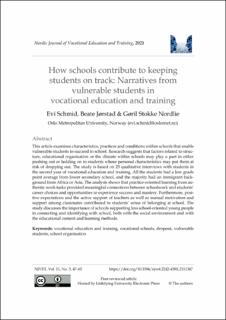| dc.contributor.author | Schmid, Evi | |
| dc.contributor.author | Jørstad, Beate | |
| dc.contributor.author | Stokke Nordlie, Gøril | |
| dc.date.accessioned | 2021-10-29T09:15:57Z | |
| dc.date.available | 2021-10-29T09:15:57Z | |
| dc.date.created | 2021-10-28T11:45:55Z | |
| dc.date.issued | 2021-10-27 | |
| dc.identifier.citation | Nordic Journal of Vocational Education and Training. 2021, 11 (3), 47-65. | en_US |
| dc.identifier.issn | 2242-458X | |
| dc.identifier.uri | https://hdl.handle.net/11250/2826483 | |
| dc.description.abstract | This article examines characteristics, practices and conditions within schools that enable vulnerable students to succeed in school. Research suggests that factors related to structure, educational organisation or the climate within schools may play a part in either pushing out or holding on to students whose personal characteristics may put them at risk of dropping out. The study is based on 25 qualitative interviews with students in the second year of vocational education and training. All the students had a low grade point average from lower secondary school, and the majority had an immigrant background from Africa or Asia. The analysis shows that practice-oriented learning from authentic work tasks provided meaningful connections between schoolwork and students’ career choices and opportunities to experience success and mastery. Furthermore, positive expectations and the active support of teachers as well as mutual motivation and support among classmates contributed to students’ sense of belonging at school. The study discusses the importance of schools supporting less school-oriented young people in connecting and identifying with school, both with the social environment and with the educational content and learning methods. | en_US |
| dc.language.iso | eng | en_US |
| dc.publisher | Linköpings University Electronic Press | en_US |
| dc.relation.ispartofseries | Nordic Journal of Vocational Education and Training;Volume 11, Issue 3 (2021) | |
| dc.rights | Navngivelse 4.0 Internasjonal | * |
| dc.rights.uri | http://creativecommons.org/licenses/by/4.0/deed.no | * |
| dc.subject | Vocational education | en_US |
| dc.subject | Vocational training | en_US |
| dc.subject | Vocational schools | en_US |
| dc.subject | Dropouts | en_US |
| dc.subject | Vulnerable students | en_US |
| dc.subject | School organisations | en_US |
| dc.title | How schools contribute to keeping students on track: Narratives from vulnerable students in vocational education and training | en_US |
| dc.type | Peer reviewed | en_US |
| dc.type | Journal article | en_US |
| dc.description.version | publishedVersion | en_US |
| dc.rights.holder | Copyright (c) 2021 Evi Schmid, Beate Jørstad, Gøril Stokke Nordlie | en_US |
| cristin.ispublished | true | |
| cristin.fulltext | original | |
| cristin.qualitycode | 1 | |
| dc.identifier.doi | https://doi.org/10.3384/njvet.2242-458X.2111347 | |
| dc.identifier.cristin | 1949216 | |
| dc.source.journal | Nordic Journal of Vocational Education and Training | en_US |
| dc.source.volume | 11 | en_US |
| dc.source.issue | 3 | en_US |
| dc.source.pagenumber | 47-65 | en_US |

